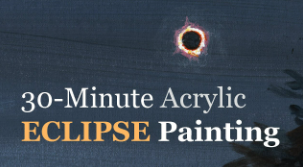- You are here:
- Home »
- Blog »
- Written Tutorial »
- How to paint Solar Eclipse: 30-Minute Acrylic Landscape Painting

How to paint Solar Eclipse: 30-Minute Acrylic Landscape Painting
Learn how to capture the solar eclipse in just 30 minutes using acrylic landscapes.
In this tutorial, we’ll guide you through creating a captivating 30-minute acrylic painting of a solar eclipse. Inspired by the recent Great American Eclipse, this lesson will teach you how to capture the dramatic lighting and unique atmosphere of the event in a fast-paced, yet comprehensive, painting session.
Materials Needed
- Acrylic Paints: Raw umber, burnt sienna, raw sienna, phthalo blue, ultramarine blue, alizarine crimson, napthol red, organic orange, Indian yellow, and titanium white.
- Brushes: Flat and round brushes (variety pack).
- Canvas: 8×10 canvas board.
- Additional Tools: Matte medium, water spray bottle.
Step-by-Step Painting Guide of 30-Minute Acrylic Landscape Painting
1. Setting the Scene
Start by setting up your canvas and palette. Begin by mixing a base color for the sky using raw umber, ultramarine blue, and titanium white. Aim for a periwinkle blue shade that will form the foundation of your sky. Apply this color across the top half of your canvas, blending it downward.
Tip: Use smooth, even strokes to cover the canvas, pushing hard to ensure the paint fills the weave of the canvas.
2. Creating Depth in the Sky
Once the base layer is applied, mix a lighter color using more titanium white and a touch of phthalo blue. Apply this lighter shade to the lower half of the sky to create a gradient effect. Add hints of indian yellow and organic orange to introduce a warm glow that reflects the twilight atmosphere of the eclipse.
Tip: Blend these colors gently where they meet to avoid harsh lines, and incorporate a few wispy clouds to enhance realism.
3. Painting the Horizon and Tree Line
For the horizon, mix a darker color with raw umber, ultramarine blue, and a bit of raw sienna. Use a flat-edged brush to block in the silhouette of the tree line. Keep the texture rough to suggest the trees and their branches without too much detail.
Tip: To create depth, use darker colors for thicker branches and lighter shades for thinner branches. This technique adds a sense of realism to your painting.
4. Adding the Solar Eclipse
As the painting progresses, focus on the solar eclipse. Mix titanium white with a small amount of napthol red and organic orange to create a base color for the eclipse. Use a small detail brush to paint the eclipse as a ring in the sky, placing it slightly off-center for a better compositional balance.
Tip: Add darker shades around the outer edge of the eclipse to emphasize its glow and create a sense of depth.
5. Enhancing Details and Final Touches
Once the eclipse is painted, add finer details such as solar prominences using a slightly lighter mixture of Titanium White and other colors. This step will bring a realistic fiery edge to the eclipse.
Tip: Use a dry brushing technique with matte medium to glaze over the painting, adding a final layer of depth and blending. Adjust the colors as needed to achieve the desired intensity and atmospheric effect.
6. Finishing Up
In the final minutes, make any necessary adjustments to the branches, add a bit more glow around the eclipse if needed, and ensure the overall balance of the painting is visually appealing.
Tip: Don’t rush the final touches; even with a 30-minute time constraint, small adjustments can make a significant difference in the overall appearance of your painting.
With this step-by-step guide, you should now have a vibrant and dramatic painting of a solar eclipse. Remember, practice makes perfect, so don’t be discouraged if your first attempt isn’t flawless. Enjoy the process and continue experimenting with different techniques to enhance your acrylic painting skills.
Read more about my additional resources, tutorials, to learn more and check my free courses. Whether you’re a beginner or an experienced artist, there’s always something new to learn and apply to your paintings. Happy painting!
LEARN MORE
- Sketching Your Painting Accurately
- Beginning a Pet Portrait in Acrylic
- The Mystery of Realism in Painting
- Apply A Burnt Sienna Glaze to a Portrait
- Learn How to Sketch a Portrait Freehand in 45 Minutes
- Adding highlights to your acrylic painting
- 5 Excellent Reasons to Use Aluminum Foil
- Paint Realistic Wrinkles in Acrylic
- Painting Clothing in an Acrylic Portrait
- Paint a Cloudy Sky Acrylic
- How to add Semi-Opaque Highlights
- How to Enhance the Contrast in Your Acrylic
- How to Add Glaze to Your Acrylic Painting
- Paint Realistic Reflections on Eyeglasses in an Acrylic Portrait
- Build Up Depth on Your Acrylic Portrait Backgrounds
- How Do You Do Layers With the Glazing Technique?
- Learn How to Paint Wrinkles in Acrylic
Read more about how to paint a portrait that you can surely be proud of!
I’d love to hear your thoughts on this video. Please share it with your friends and family. Let me know if you have any further questions. I’ll greatly help you.
If you’d like to learn more, sign up for my free email tips and video class today.
Learn How to Paint Acrylic Portraits With My Free Mini-Video Course!Thank you so much for taking the time to read this tutorial and watch the video. That means a lot to me. I hope you find it very helpful in your portrait painting.
Yours for Better Portraits,
P.S. Did you find this post helpful or encouraging? If so, send it in ahead! Let others know with the share buttons below. I’d love to hear your comments. Thank you so much! Also, do you have a question on acrylic portrait painting you’d like answered? Let me know, and I’d be happy to help!
